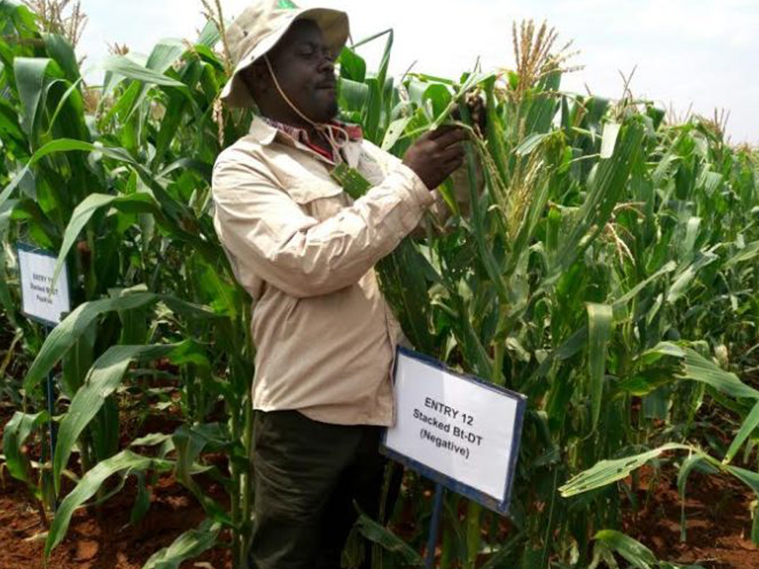Kenya’s recent ban on maize imports from her two East African neighbors due to high levels of mycotoxins has jolted the national consciousness towards the recurrent danger of toxins in food, while underscoring the need for adoption of safer food production and handling alternatives.
Earlier in March, the Agriculture and Food Authority (AFA) slapped a ban on maize imports from Uganda and Tanzania, saying tests on the maize had revealed high levels of mycotoxins “that are consistently beyond safety limits”.
Mycotoxins, particularly aflatoxins, have posed a raging threat to food security, livelihoods and human life in the country. Aflatoxin is a toxic fungal metabolite that is classified as a Group I carcinogen and which occurs naturally in maize and a number of other cereal foods. It is known to cause liver cancer in humans, as well as immune system dysfunction, and growth impairment in humans and animals.
“Over the years a number of acute and chronic aflatoxin related illness cases have been recorded in Kenya, including deaths,” AFA noted in the directive banning maize imports.
Advances in biotechnology have presented a viable solution to the nagging problem of aflatoxin, with experts citing Bt maize as a strong candidate that could help mitigate perennial food losses and fatalities associated with the notorious toxin.
A report titled “The Impact of Bt Corn on Aflatoxin- Related Insurance Claims in the United States” highlights a study running between 2001-2016, in which a significant inverse correlation was found to exist between Bt corn planting and aflatoxin-related insurance claims in the United States.
“Estimated benefits of aflatoxin reduction resulting from Bt corn planting are about $120 million to $167 million per year over 16 states on average,” states the report, released in 2020. “These results suggest that Bt corn use is an important strategy in reducing aflatoxin risk, with corresponding economic benefits”.
Acknowledging that studies had not, as yet, conclusively suggested lower aflatoxin levels in Bt corn than in non-Bt varieties, the study nevertheless makes a strong case for adoption of Bt maize as a way to reduce the incidence of aflatoxin in maize reserves. According to Dr Sylvester Oikeh, field practices invariably impact the quality of food post-harvest.
“Significant impact starts in the field. So if you prevent the crop from being contaminated in the field, such risks would not be carried over to the store. Bt will not only protect the crop from insect pests and increase yields for farmers, it will also help to provide better grain quality, which can be stored without having these mycotoxin infestations.”
Dr Oikeh is the project manager of the TELA Maize Project, a public-private partnership that is addressing the problem of drought in maize and destructive insects specifically stem-borers and fall armyworm. The project is led by the African Agricultural Technology Foundation (AATF) through support of the Bill and Melinda Gates Foundation and the United States Agency for International Development.
The country loses about 15% of its maize crop to the maize borer annually, notes Dr Oikeh, which amounts to 400,000 tonnes of maize, the equivalent of US$ 19 million.
“Coincidentally, the same US$ 19 million is spent annually to import maize into the country to bridge the food gap,” Dr Oikeh said. “It means that if you address the problem of stem borer, you will contribute significantly to addressing food security in Kenya.”
Kenya has achieved significant milestones in Bt maize research.
“The TELA Bt maize reduces the need for sprayed insecticides, making the process of farming maize much safer for farmers, consumers and the environment,” says Dr Mwimali Murenga, senior principal research scientist at Kenya Agricultural and Livestock Research Organization (KALRO). “Trial results in Kenya show that TELA Bt maize effectively controls the two major stem borer pests in Kenya (the spotted stem borer (Chilo partellus) and the African stem borer (Busseola fusca), and shows some level of tolerance to fall army worm.”
Dr Murenga notes that effective control allows the seed to realise its full yield potential, adding that trials have shown Bt maize out yielding the commercial hybrids by 3.7 tonnes per ha. In addition to improved yields and reduced insect damage, the end result is improved maize grain quality making it less exposed to fungus or moulds that cause aflatoxin.
“In East Europe, levels of mycotoxins were significantly lower in Bt maize than in conventional maize. The TELA Bt maize reduces the need for sprayed insecticides, making the process of farming maize much safer for farmers, consumers and the environment.”
Dr Murenga, who holds a doctorate in plant breeding and a master’s in plant breeding and genetics with a focus on insect-protected Bt maize, is also the country coordinator for the Water Efficient Maize for Africa (WEMA) Kenya Project, where he is responsible for the development of drought- and stress-tolerant and stem borer-resistant GM maize.
Recent interactions with a cross section of Kenyan maize farmers at the (KALRO) National Performance Trial (NPT) site in Thika, Muranga County, which is part of the TELA maize project, painted a positive picture of warm reception for Bt maize among farmers in the country, with the farmers expressing optimism for the much superior Bt variety.
The article is written by Joseph Maina for the People Daily online.



















































































